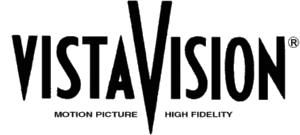

Paramount's VistaVision specifications created a very flexible large format negative that could be printed in either a direct 8 perforation contact print or an optical reduction standard flat(non-anamorphic) print. Though there was some brief toying with the idea of creating squeezed 35mm prints with an aspect ratio of 2:1 using 1.5xanamorphic projection lenses, if any such prints were ever put into distribution we have not been able to locate documentation of this fact. Included on this page is documentation of the camera aperture and 4 perf & 8 perf recommended specs.
Camera Aperture and 4-Perf Print Specs.
Seen at left is an 8 perf contact print from Vertigo made during the Harris/Katz restoration. Overlaid in yellow is the original Paramount dimensional drawing calling out camera aperture, printer aperture, and extraction areas for 35mm optical reduction prints along with projector aperture dimensions for the recommended 1.66:1 screen ratio.
The camera aperture is 1.472" x .997", an aspect ratio of 1.47:1. A large percentage of this area is not designed to be seen on the screen. Production of a 35mm reduction print entails a 90 degree rotation of the image and an optical reduction ratio of 1.63.
The broken line boundary seen in the illustration represents the maximum printer aperture dimensions of 1.4148" x .840", an A/R of 1.68:1. Just inside that boundry is the area used by Technicolor to manufacture the reduction prints with a dimension of 1.3985"x .8203", an A/R of 1.7:1, which translates to an image size of .858" x .5035" on the final print.
The inner most boundary is the 1.66:1 projector aperture dimension, 1.3447" x .810", or .825" x .497" on the reduction print.
Whether using a 4 perforation optical reduction print or an 8 perforation Eastmancolor contact print, the recommended projector aperture ratios always maintained a common headroom with varying aspect ratios using more or less width in the case of 8 perf, and always sacrificing the lower part of the frame in both 4 and 8 perf formats. Maximum useable image width was dictated by the size of splices in the original 8 perf negative.
Since it is impossible to view the technical drawing details on this small image, you may download a very large copy of the drawing in GIF format.
Click Here to view VVDIMS1.GIF (1536x1322 pixels, 54.7k)

This is what remains of an Eastman 8-perf horizontal print of To Catch A Thief, produced by Technicolor in 1955. Technicolor never established a dye transfer line for any large format wide screen system because the economics were unfavorable for the limited number of prints required. Thus we see a very monochrome surviving print.
The outer yellow boundary indicates the full camera aperture area captured on the negative. As you can see, the optical sound track has replaced the upper part of the image.
Inside that boundary are two more yellow boundaries, the wider indicating the projector aperture dimension for an aspect ratio of 1.96:1. This is the absolute maximum useable width, and even at that a sloppy splice could be visible at the edges of the picture. The aperture dimension is 1.4180" x .7228".
The narrower boundary marker shows the projector aperture for an aspect ratio of 1.85:1, with a dimension of 1.3365" x .7228".
In this illustration I have rotated the Paramount drawing 180 degrees before laying it over the print. To view a high resolution GIF version of the technical drawing Click Here. (VVDIMS2.GIF - 1602 x 948 pixels - 41.5k)
From an initial camera aperture of 1.4716 sq. in., the maximum image area used in a 1.66:1 screened image would be taken from an area of just 1.089 sq. in. The more commonly used 1.85:1 screen ratio would utilize an image extracted from .966 sq in. While VistaVision and Technirama share similar camera negative dimensions, the Technirama print is made from nearly the full available negative, an area 50% larger than used in most VistaVision showings. Initially Technirama's camera aperture did not include the area that would contain an optical sound track in an 8 perf print. With the advent of Super Technirama 70mm blowup prints, the camera aperture was opened up to a dimension identical to VistaVision's, yielding a 2.25:1 anamorphic negative from which the 2.21:1 70mm blowup could be made.
©1997 - 2000 The American WideScreen Museum
http://www.widescreenmuseum.com
Martin Hart, Curator